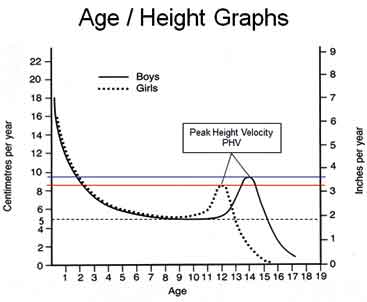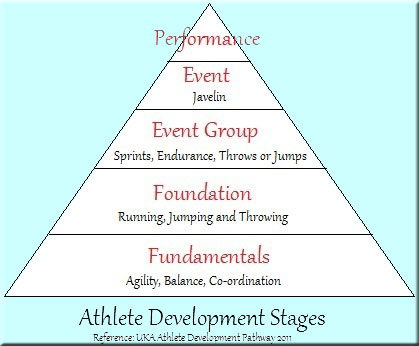

Coaching Young Athletes
Young athletes are physically developing, from early childhood to late adolescence. This means they have different capabilities for and adaptations to exercise, and for this reason, young athlete training programs should not be scaled-down versions of adult training programs.
Growth rates
In the first two years, children grow about 5 inches (13 cm). Growth then continues at a steady rate of 2.5 inches (6 cm) per year until about the age of 11 in girls and 13 in boys, when the pubertal growth spurt begins.
The pubertal growth spurt lasts about two years. It is accompanied by sexual development (growth of pubic hair, development of sex organs, deepening of the voice in boys, and the beginning of menstruation in girls). Average growth stops when the growing ends of the bones fuse.

This usually occurs between 12 and 15 for girls, and 14 and 17 for boys. The typical pattern of the rate of growth for boys and girls from birth through adolescence is shown in the figure "Growth Rates for Boys & Girls" (Rieser 2002)[1]. This growth rate is an essential factor in a child's Long-Term Athlete Development (LTAD).
Bone development
Bones develop from cartilage growth plates, called epiphysial plates, at each end of the bone shaft. These growth plates divide the calcified head of the bone (epiphysis) and the calcified shaft (diaphysis). The bone lengthens as cartilage is calcified into bone. At the same time, cartilage continues to grow on the epiphysial border, so the epiphysial plates retain a constant width of cartilage throughout. Growth ends when the plate eventually calcifies.
Muscles
Muscle mass increases steadily until puberty, at which point boys show faster muscle growth.
Fat
The hormonal changes at puberty also affect body composition in terms of fat.
- At birth, both boys and girls have around 10 to 12% body fat.
- Pre-puberty, both girls and boys still have a similar 16-18% body fat.
- Post-puberty, girls have around 25% body fat due to high serum oestrogen, which causes the hips to widen and extra fat to be stored in the same area.
- Post-puberty, boys have 12 to 14% body fat.
Post-puberty, most athletic females keep body fat at around 18% (Wilmore & Costill, 1994)[2]. Any lower than 12% body fat for females can be considered unhealthy maintaining bone density and disrupting hormone levels, which may increase the risk of stress fractures.
Coaches need to ensure female athletes are aware that until they are 19, they will steadily gain muscle and naturally gain weight and that eating the right kinds of foods is the way to avoid unwanted weight gain.
Potential growth-related injuries
The change in female body shape during the growth spurt has particular injury risks. The hips widen, placing the femur at a higher inward angle. This increased femur angle leads to a greater inward rotation at the knee and foot during running or walking. This rotation can result in a chondromalacia patella injury when the knee cap does not run smoothly over the knee joint and pain is caused at the front of the knee. Appropriate preventive training to avoid chondromalacia patella would strengthen the vastus medialis muscle, the lower abdominals, obliques (side of stomach), hip abductor and hip external rotator muscles.
Traction injuries are another type of injury associated with bone growth. They are caused by repetitive loading while the tendon is sensitive to stress as the bones and tendons are fusing. Traction injuries occur at different sites at different stages of growth.
- 10 to 13 years of age - at the heel (Sever's disease).
- 12 to 16 years of age - at the knee (Osgood Schlatter's disease).
- Late adolescence - lower back and iliac pain.
The only cure for these traction injuries is rest.
Exercise
Exercise will neither stunt nor promote growth in terms of height, but it does thicken the bones by increasing mineral deposits (Wilmore & Costill, 1994)[2].
The epiphysial plate is susceptible to injury. A fracture to the epiphysial plate before full growth could be a severe injury as it could disrupt bone growth. Growing bones are sensitive to stress, so repetitive loading should be avoided.
A more common kind of epiphysial plate injury, and the one coaches must take care not to cause, is called epiphysitis. This repetitive strain injury occurs when excessive loads are placed on the tendons attached to the epiphysis, causing an inflammatory response. In extreme cases, this type of injury can separate the epiphysis from the epiphysial plate. The most common epiphysitis, called Little Leaguer's Elbow, occurs mainly among young baseball pitchers in the USA.
Use of steroids
Anabolic steroid use in young athletes can stunt growth by causing premature calcification of the epiphysial plate (Strauss & Yesalis 1991)[3].
Strength training
From research by Weltman et al. (1986)[4] carried out on the effects of resistance training on young athletes, it would appear that, in general, strength improvements are possible. If coaches are to place young athletes in strength training programs, then they must ensure:
- Young athletes are properly taught (skill development).
- Young athletes undertake a well-controlled progressive program (planning).
- Young athlete's joints are not subject to repetitive stresses (injury prevention).
Strength can be developed with circuit training programs where the young athlete's body weight is used as the load.
Aerobic and anaerobic development
The aerobic ability of young athletes can be developed, so it makes aerobic training worthwhile since it will improve their performance. Anaerobic training is of limited use to young athletes as they possess little anaerobic capacity and is perhaps best left until the young athlete reaches adolescence. Aerobic and Anaerobic Development, an article by Brandon (2003)[5] explores the benefits of aerobic and anaerobic training for young athletes.
Skill development
The development of sport-specific skills and agility, balance and coordination are important areas to focus on when coaching young athletes.
Training Programs
Long Term Athlete Development (LTAD) is a sports development framework that matches the training needs for a child's growth and development. In athletics, a novice athlete will go through the following stages of development:
- Fundamentals - developing agility, balance, and coordination.
- Foundation - developing run, jump, and throw skills.
- Event Group - developing the athletic event skills associated with the Sprints, Endurance, Jumping or Throwing.
- Event - develop the skills specific to one athletic event.

Athletics 365 can be used to develop athletes in the Fundamental and Foundation stages.
The following are links to suggested training programs for the Event Group athlete:
- Sprint events - 100m, 200m, 400m, 4×100m relay and 4×400m relay.
- Endurance events - 800m, 1500m, 5k, 10k, Walks and Steeplechase.
- Throw events - Discus, Shot, Javelin and Hammer.
- Jump events - High Jump, Long Jump, Triple Jump and Pole Vault.
Coaching Children
Coaches of young children need to ensure that every child or young person who participates in athletics can join in a fun and safe environment and be protected from neglect and physical, sexual and emotional abuse. For more details, read the Scottish Athletics Federation (SAF) policy for Child Protection in Athletics.
References
- RIESER, P. and UNDERWOOD, L. (2002) Growing Children: A Parent's Guide. 5th ed. Genentech Inc
- WILMORE, J. H. and COSTILL, D. L. (1994) Physiology of sport and exercise. Human Kinetics, Champaign, Illinois
- STRAUSS, R. H. and YESALIS, C. E. (1991) Anabolic Steroids in the Athlete. Annual Review of Medicine, 42, p. 449-457
- WELTMAN, A. et al. (1986) The effects of hydraulic resistance strength training in pre-pubertal males. Med Sci Sports Exerc. 18 (6), P. 629-638.
- BRANDON, R. (2003) Aerobic and Anaerobic Development [WWW] Available from: https://www.brianmac.co.uk/articles/scni4a3.htm
Page Reference
If you quote information from this page in your work, then the reference for this page is:
- MACKENZIE, B. (2000) Coaching Young Athletes [WWW] Available from https://www.brianmac.co.uk/children.htm [Accessed